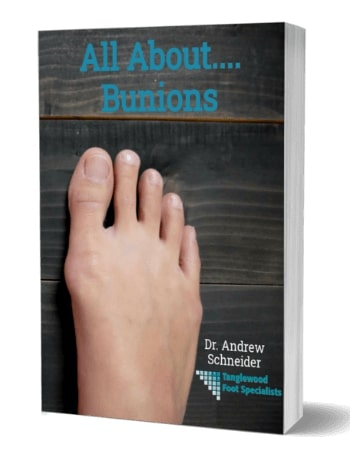Are you wondering, is plantar fasciitis hereditary? Or is your grandma to blame for your bunions? Do you ever feel like you're just looking for something or someone to blame for trouble? Something hurts on your body, and you want to find someone else to take all the blame. We’re all about cause and effect, especially with our patients.
That's why, when we meet you for the first time, we'l be split between the present and the past. Of course, we'll focus on what you're dealing with right now. But we'll also ask who or what we can blame for this development.
Now, you might be surpirsed when we ask you, “Who else in your family has bunions?” We're not telepathic. But we are students of foot and ankle problems. And many of them are hereditary.
Of couse, something that's hereditary doesn’t have to happen to you. But it does increase your risk. Plus, it gives us ammunition to predict and fight the forces of heredity. This way, together, we can prevent problems and keep you walking comfortably.
 Since we used bunions as an example already, let's start with this one. When it comes to bunions, you may blame shoes for causing them. But shoes get a bad rap. They can make a bunion worse, but rarely is a shoe the cause of a bunion.
Since we used bunions as an example already, let's start with this one. When it comes to bunions, you may blame shoes for causing them. But shoes get a bad rap. They can make a bunion worse, but rarely is a shoe the cause of a bunion.
You are predisposed to forming a bunion based on your foot type. Each foot type comes along with certain foot mechanics. With each step, someone with a tendency for a bunion will roll off the big toe. This puts a pressure backwards to the metatarsal bone and causes it to shift out. A bump on the side of the big toe joint is formed. There’s your bunion.
Most people aren’t born with a bunion. It develops over time. So, if you catch a bunion early, you can prevent it from forming. First, you can reach and maintain a healthy weight. You can also wear appropriate shoes, But you must also change the mechanics of your feet. Sounds hard? It’s easier than you’d think. We work with a specialized insole called custom orthotics. An orthotic balances the faulty mechanics. This removes the forces that develop a bunion.
-
Flat Feet
 Whenever we see someone with flat feet, they’re usually attributed to a family member. “I have my father’s feet.” And as you say it, you think about the discomfort that dad had with his feet. He may not have enjoyed walking long distances. He probably didn’t play a sport or even exercise. And you don’t want to fall into the same mold.
Whenever we see someone with flat feet, they’re usually attributed to a family member. “I have my father’s feet.” And as you say it, you think about the discomfort that dad had with his feet. He may not have enjoyed walking long distances. He probably didn’t play a sport or even exercise. And you don’t want to fall into the same mold.
Flat feet provide an unstable base of support. So, when you stand on your flat feet, other joints need to work extra hard to provide the stability. That’s why people with flat feet often complain of pain in their feet, ankles, knees, hips, or back. The feet can’t support their activity.
Now, flat feet may lead to heal pain. Which is why, in this case, the answer may be yes if you ask, "Is plantar fasciitis hereditary?" But you don't have to develop heel pain with flat feet. We can intervene in several ways.
Of course, we can add stability to a flat foot. That’s done using a custom orthotic. We design the orthotic to provide stability and efficiency to your base of support. It allows your feet to do their share of supporting your activity. In doing so, it takes the pressure off of your ankles, knees, hips, and back. And once you’re feeling better, send your dad in to get a pair too!
But we can also recommend these stretches for flat feet to fight your so-called hereditary plantar fasciitis.
1. Use a towel.
Sit down on a chair and place your ball of foot in the middle of the towel, holding the ends in both your hands. With a straight leg, gently pull the towel so your toes move toward your face. This should take some pressure off your calf muscles, which often get overworked with flat feet since they help support your foot arch.
2. Go straight to the zone
The next stretch directly targets your arch. Start by sitting with your feet flat on the ground. Now, try to get the ball of your foot closer to your heel by lifting your arch while keeping your toes and heel on the floor. Try to lift your arch 10 times per set, aiming to complete five sets on each foot. This helps strengthen your foot arch, which can reduce the pain of a flexible flat foot.
-
High-Arched Feet
If dad had flat feet, then you must have inherited those high-arched feet from mom. Mom always was excited about her arch. After all, the higher the arch, the better off you are, right? Must have been from all those years of ballet.
Of course, that's all sarcasm. Having an excessively high-arched foot can be just as problematic as having flat feet. Where a flat foot has too much motion, a high-arched foot doesn’t have enough. Because of this, your foot won’t have enough shock absorption when you walk or run. This leads to foot pain, shin splints (medial tibial stress syndrome) and stress fractures.
Shin splints are pesky. You may notice a dull, aching pain on the inside of your lower leg bone, whether you're moving or resting. It may even feel tender to the touch. And, if you try to massage the area, you could feel something like a knot around the site of the pain. These are all signs that your muscles are inflamed. But, if you notice bruising or swelling, you may have a stress fracture. And that means you've gotten small cracks in your muscle bones. While both injuries are common for people with high arches, they can be prevented. We'll just have to work a little harder.
In this case, we can’t rely on a custom orthotic alone. An orthotic will not add mobility to this foot type. At best, it can redistribute the pressures so you’re not overloading one particular area. An orthotic must be worn in conjunction with a proper shoe. Wearing a well-made neutral running shoe is essential. It provides the shock absorption that your foot doesn’t naturally have.
 You might not think about ingrown toenails as something that is hereditary. It’s true, that some cases of ingrown toenails are user error. You cut your toenails improperly and that leads to an ingrown toenail. Would you believe that it is more common to have an ingrown toenail for other reasons?
You might not think about ingrown toenails as something that is hereditary. It’s true, that some cases of ingrown toenails are user error. You cut your toenails improperly and that leads to an ingrown toenail. Would you believe that it is more common to have an ingrown toenail for other reasons?
The most common cause of an ingrown toenail is the toenail being too wide for the nail bed. That’s it. You can’t blame faulty nail trimming. You don’t have to curse the overzealous pedicurist. You were just built that way. And here’s the thing, your ingrown toenails may never bother you. But one day they might.
The best time to get your ingrown toenails checked is right when they are starting to become sore. But you want to come in before they become too inflamed or infected. The procedure to treat an ingrown toenail is straightforward. It is also very easy to recover from. If it’s infected, we lose the opportunity to treat it permanently. Wouldn’t it be best to have one procedure rather than many?
 Not every case of diabetes is hereditary. That said, most who develop diabetes has a genetic predisposition. I have the genetics myself. In fact, I had a blood test this week and found out that I am not diabetic. But the thought that I could be did cross my mind.
Not every case of diabetes is hereditary. That said, most who develop diabetes has a genetic predisposition. I have the genetics myself. In fact, I had a blood test this week and found out that I am not diabetic. But the thought that I could be did cross my mind.
Diabetes has serious consequences for the feet. They can become numb because of peripheral neuropathy. They could have poor blood flow. And everyone with diabetes has a reduced capacity to heal. Put these all together and it’s pretty bad. What’s worse? You can develop an open sore on your foot known as a diabetic foot ulcer.
A diabetic foot ulcer is a hole in the skin due to overloaded pressure on the bottom of the foot. It occurs when your diabetes is not well controlled. It also can happen when the pressure builds up beneath your foot, but you don’t feel it because your feet are numb. It leads to the skin breaking down and developing a diabetic foot ulcer.
You can fight this hereditary condition in two ways. First, take care of yourself. If you have diabetes or pre-diabetes, take it seriously. Don’t just take your medication. You need to watch your diet as well. It makes a difference. You also need to come in for periodic diabetic foot checks. How often depends on how well controlled your diabetes is. We’ll discuss the frequency when you come in.
If you see yourself in any of these conditions, then it’s time to start reversing the effect of genetics. Give us a call at the office and we’ll get you in for an immediate consultation. Remember, waiting for there to be a problem will only make the treatment more involved later. It’s cliché but it’s true…an ounce of prevention is worth a pound of cure.
























